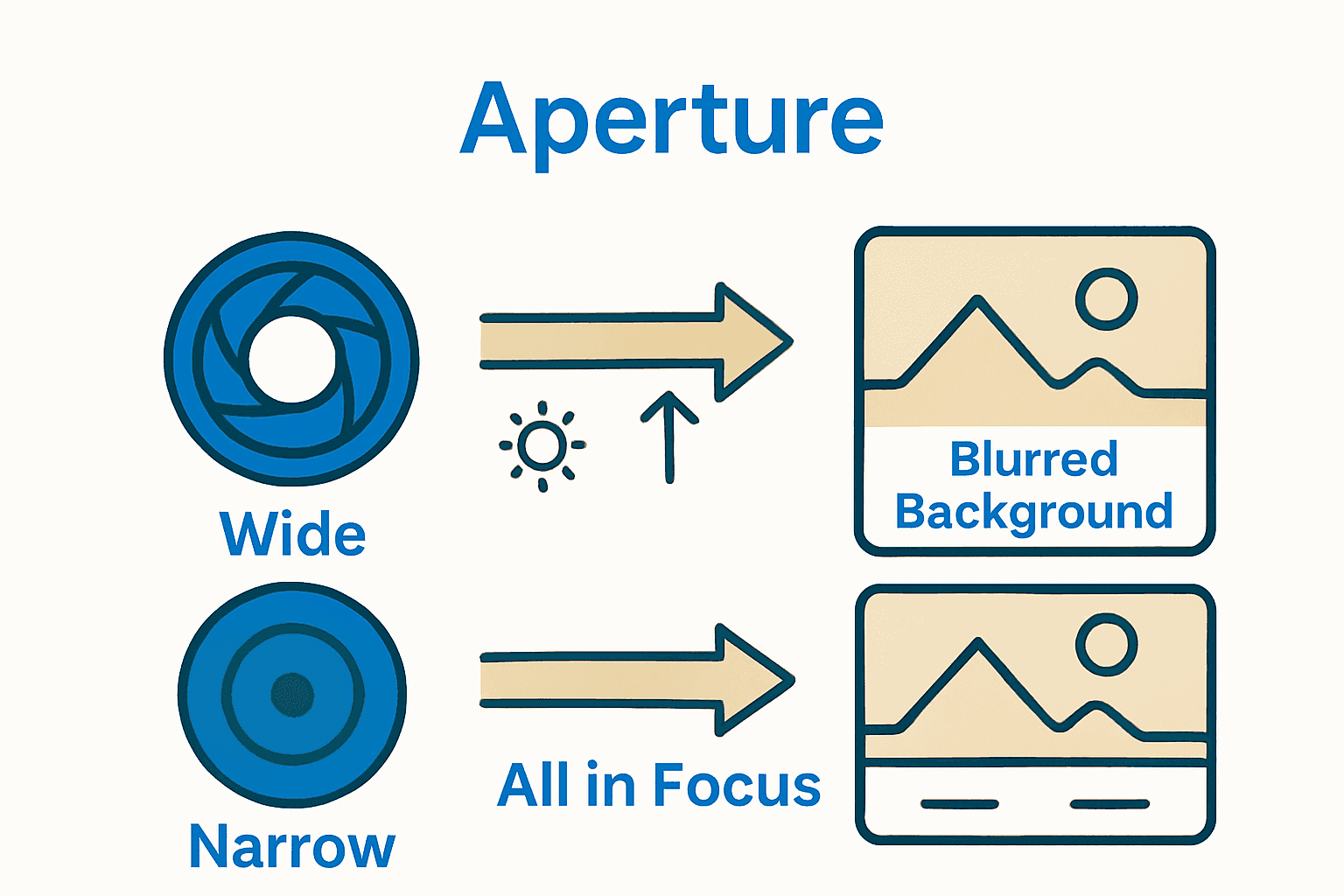Table of Contents
- Key Takeaways
- What Is Aperture In Photography?
- How Aperture Affects Exposure And Light
- F-Stop Numbers And Aperture Sizes Explained
- Aperture’s Role In Depth Of Field Control
- Common Aperture Mistakes And How To Avoid Them
- Unlock the Full Power of Aperture in Your Photography
- Frequently Asked Questions
- Recommended
This blog post may contain affiliate links. As an Amazon Associate I earn from qualifying purchases.
Over 60 percent of american photographers say mastering aperture changed the way they capture images. The size of the lens opening does more than just control brightness, it decides how much of your photo is sharp and how much melts into softness. Understanding how aperture works helps you shape both light and mood, whether you want crisp landscapes or dreamy portraits. This guide reveals the simple science behind aperture so you can take control of every shot.
Key Takeaways
| Point | Details |
|---|---|
| Aperture Controls Light | The aperture setting determines the amount of light entering the camera, affecting image brightness and exposure. |
| Relationship with Depth of Field | Aperture is a key factor in controlling depth of field, influencing focus and background blur in images. |
| F-Stop Numbers Explained | Lower f-stop numbers indicate wider openings, allowing more light in, while higher numbers denote narrower openings. |
| Avoid Common Errors | Understanding the optimal aperture range for different scenarios can prevent issues like diffraction and poor image quality. |
What Is Aperture In Photography?
Aperture represents the adjustable opening within a camera lens that controls light entry and dramatically shapes photographic outcomes. Think of it like the pupil in your eye: sometimes wide open, sometimes narrow, always adapting to surrounding conditions. Just as your eye adjusts to let in more or less light, a camera’s aperture does the same thing, fundamentally influencing image exposure and visual depth.
At its core, aperture functions through a mechanical diaphragm that expands and contracts inside the lens. Photographers measure this opening using f-stops, which might seem counterintuitive at first. Lower f-numbers like f/1.8 actually represent wider lens openings, while higher f-numbers like f/16 indicate much narrower openings. This relationship means that f/1.8 allows significantly more light to reach your camera’s sensor compared to f/16. The choice depends on your creative vision and shooting environment.
The magic of aperture extends beyond light control. It plays a pivotal role in creating depth of field – determining how much of your image appears sharp and in focus. Wider apertures (lower f-numbers) produce a shallow depth of field, beautifully blurring backgrounds and making subjects pop. Narrow apertures (higher f-numbers) keep more of the scene crisp and detailed, perfect for landscape photography where you want everything from foreground to background razor-sharp. Understanding these nuances transforms technical knowledge into artistic expression.

While mastering aperture takes practice, the fundamental principle remains simple: you’re controlling light and focus simultaneously. Want to dive deeper into how aperture interacts with other camera settings? Check out our tutorial on aperture priority mode to unlock more advanced shooting techniques.
How Aperture Affects Exposure And Light
Light is the fundamental currency of photography, and aperture serves as the primary mechanism for controlling its entry into your camera. By adjusting the lens opening, photographers can dramatically manipulate image brightness and overall exposure. Think of aperture like a water faucet – a wider opening allows more light to flood through, while a narrower opening restricts the flow, creating nuanced control over your photographic results.
The relationship between aperture and exposure is direct and powerful. F-stops – those seemingly cryptic numbers like f/2.8 or f/16 – represent precise measurements of light intake. Wider apertures (lower f-numbers) allow exponentially more light to reach the camera sensor, which is crucial in low-light environments like indoor settings or nighttime photography. Conversely, narrow apertures (higher f-numbers) restrict light, preventing overexposure in bright conditions like midday sunlight. This mechanical dance between lens opening and light intake gives photographers incredible creative flexibility.
Understanding exposure isn’t just about brightness – it’s about balance. Aperture works in a delicate trinity with shutter speed and ISO to create perfectly exposed images. When you open the aperture wider, you’ll typically need faster shutter speeds or lower ISO to prevent overexposure. When you narrow the aperture, you might need slower shutter speeds or higher ISO to maintain proper image brightness. This intricate interplay means that mastering aperture requires both technical knowledge and artistic intuition.
Want a deeper dive into photographic exposure techniques? Our comprehensive guide on exposure in photography will help you understand these complex relationships and transform your image-making skills from technical to truly artistic.
F-Stop Numbers And Aperture Sizes Explained
Photographers often find f-stop numbers bewildering at first, but they’re actually a precise mathematical language describing lens openings. These seemingly cryptic numbers like f/1.4, f/2.8, f/8, and f/16 represent the ratio between a lens’s focal length and its actual opening diameter. Counterintuitively, lower f-numbers indicate wider lens openings, while higher numbers represent narrower openings – think of it like a fraction where smaller denominators mean larger openings.
The relationship between f-stop numbers follows a geometric progression that might seem complex but becomes intuitive with practice. Each full f-stop represents a doubling or halving of light entering the camera. For instance, moving from f/4 to f/5.6 means cutting light transmission by half, while moving from f/4 to f/2.8 doubles the amount of light reaching your camera’s sensor. This precise light control allows photographers to make nuanced exposure decisions in rapidly changing environments.
Understanding f-stop progression helps photographers make intentional creative choices. Standard f-stop sequences typically follow this pattern: f/1.4, f/2, f/2.8, f/4, f/5.6, f/8, f/11, f/16, f/22 – with each step representing a consistent light reduction. Professional photographers often adjust these settings intuitively, balancing light intake with desired depth of field and creative vision. Whether you’re shooting a dimly lit concert or a bright landscape, mastering f-stop numbers transforms technical knowledge into artistic expression.
Want to dive deeper into the technical aspects of camera settings? Check out our comprehensive guide on f-stops to unlock the full potential of your camera’s capabilities.
Aperture’s Role In Depth Of Field Control
Depth of field represents the magical zone of sharpness in a photograph, and aperture serves as the primary artistic tool for controlling this visual phenomenon. Imagine your camera lens as a focusing lens that can blur or sharpen different parts of an image – wider apertures create a narrow depth of field with soft, dreamy backgrounds, while narrower apertures produce crisp, detailed scenes where everything from foreground to background appears in sharp focus.
The relationship between aperture and depth of field follows a predictable yet powerful pattern. Wider apertures like f/1.4 or f/2.8 create extremely shallow depth of field, perfect for portrait photography where you want to isolate a subject against a beautifully blurred background. Conversely, smaller apertures such as f/11 or f/16 dramatically increase the depth of field, making them ideal for landscape photography where you want every detail from nearby rocks to distant mountains to remain crystal clear. This precise control allows photographers to transform ordinary scenes into extraordinary visual narratives.

Professional photographers use depth of field as a storytelling technique, strategically choosing aperture to guide viewers’ attention. A wildlife photographer might use a wide aperture to make a leopard pop against a soft, indistinct background, while an architectural photographer would select a narrow aperture to capture every intricate detail of a building’s facade. The aperture becomes more than a technical setting – it’s a creative brush that paints visual stories, controlling what viewers see and how they interpret an image.
Want to explore the nuanced world of photographic focus? Our comprehensive depth of field guide will help you master this essential technique and unlock new dimensions of photographic creativity.
Common Aperture Mistakes And How To Avoid Them
Many photographers, especially beginners, fall into predictable traps when working with aperture settings. Aperture misconceptions can transform potentially stunning images into frustrating disappointments. The most common error is blindly following the assumption that smaller apertures (higher f-numbers) are always better for landscape photography or that wider apertures work universally for portraits.
Understanding the nuanced relationship between aperture and image quality is crucial. Photographers often mistakenly use the smallest possible aperture like f/22, believing it guarantees maximum sharpness across an entire scene. However, this approach can actually introduce diffraction, a technical phenomenon that reduces overall image clarity. Most lenses perform best in their middle aperture ranges – typically around f/8 to f/11 – where optical performance remains consistently sharp. Additionally, many beginners forget that changing aperture dramatically impacts other exposure settings, requiring simultaneous adjustments to shutter speed and ISO to maintain proper image brightness.
Professional photographers develop an intuitive understanding of aperture’s complex effects. They recognize that each lens has a sweet spot where optical performance peaks, and they’re not afraid to experiment with different settings to achieve specific creative outcomes. Critically, they understand that aperture isn’t just a technical setting but a powerful storytelling tool. A wildlife photographer might choose a wide aperture like f/2.8 to isolate a leopard against a blurred background, while an architectural photographer would select a narrower aperture to capture intricate structural details with razor-sharp precision.
Want to dive deeper into avoiding common photographic pitfalls? Check out our comprehensive guide on photography mistakes to transform your technical understanding into artistic mastery.
Unlock the Full Power of Aperture in Your Photography
Mastering aperture is essential for controlling light and depth of field but it can feel overwhelming to balance f-stops, exposure, and creative vision all at once. If you find yourself struggling with technical terms like “f/2.8” or unsure how aperture affects your images’ sharpness and mood you are not alone. Many photographers want clear guidance on avoiding common mistakes and making confident settings choices that bring their artistic ideas to life.

Take control of your photography journey today by exploring practical tutorials and expert insights at Amateur Photographer Guide. From detailed explanations on aperture priority mode to mastering the interplay of exposure settings in our comprehensive exposure guide you will find everything you need to transform theory into stunning photos. Don’t wait to enhance your skills and create visuals that truly stand out. Visit Amateur Photographer Guide now to start putting aperture knowledge into practice with confidence.
Frequently Asked Questions
What is aperture in photography?
Aperture is the adjustable opening in a camera lens that controls how much light enters the camera. It significantly impacts exposure and depth of field in an image.
How does aperture affect exposure?
Aperture directly influences exposure by controlling the amount of light hitting the camera sensor. Wider apertures (lower f-stop numbers) allow more light, while narrower apertures (higher f-stop numbers) reduce light intake, affecting the overall brightness of the image.
What is depth of field, and how does aperture influence it?
Depth of field refers to the range of distance within a photo that appears sharp. A wider aperture creates a shallow depth of field, blurring the background, while a narrower aperture increases depth of field, keeping more of the scene in focus.
What are common mistakes to avoid when using aperture settings?
Common mistakes include assuming higher f-stop numbers always yield better sharpness and not adjusting other exposure settings like shutter speed and ISO when changing aperture. It’s also vital to remember that most lenses have a ‘sweet spot’ where they perform best optically, typically between f/8 and f/11.
Recommended
- Understanding Exposure: How to Get the Perfect Shot – Amateur Photographer Guide
- What Is Aperture Priority Mode, And When Should You Use It? – Amateur Photographer Guide
- Depth of Field Explained – Amateur Photographer Guide
- The Beginner’s No-Fear Guide to Basic Camera Settings [Photographer-Approved] – Amateur Photographer Guide

